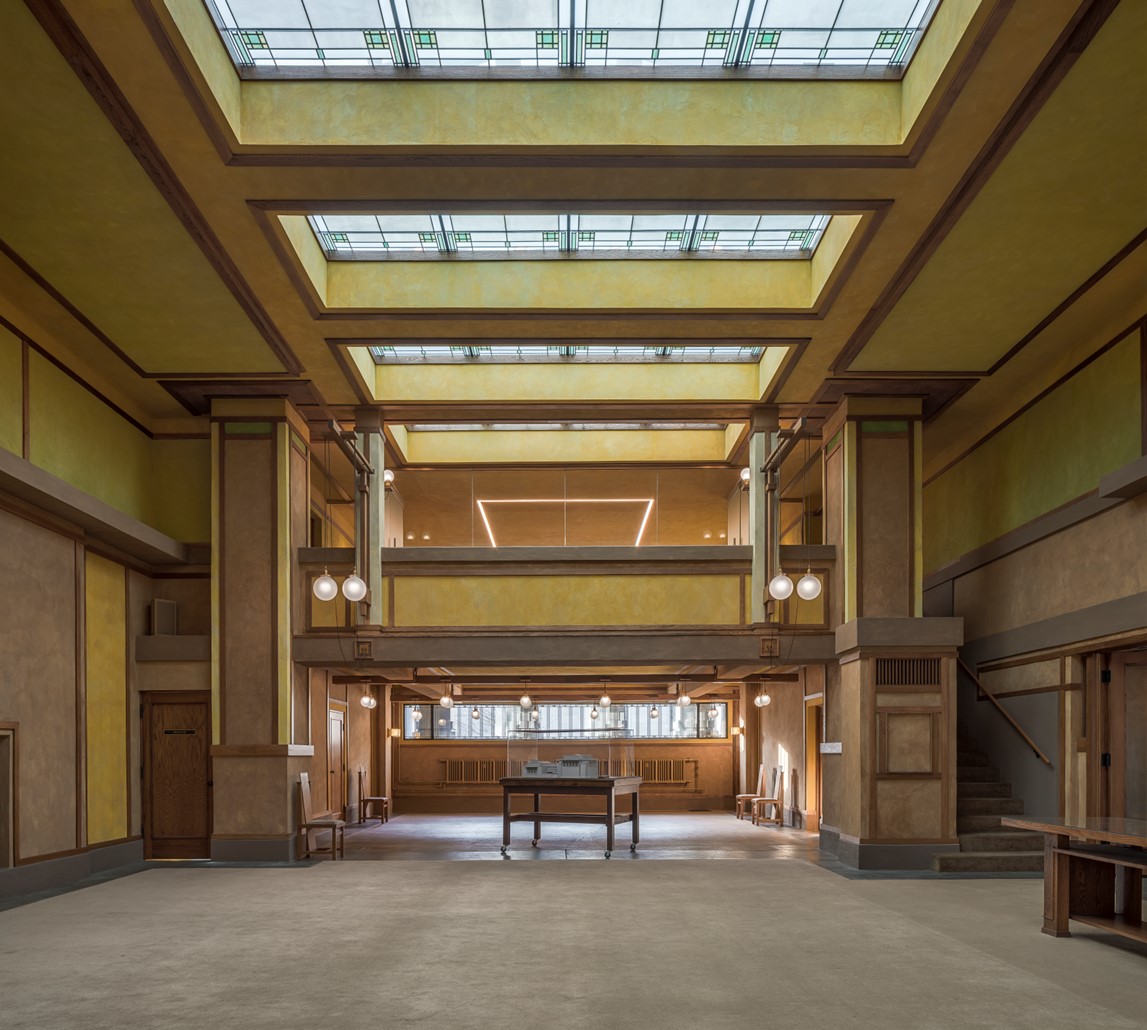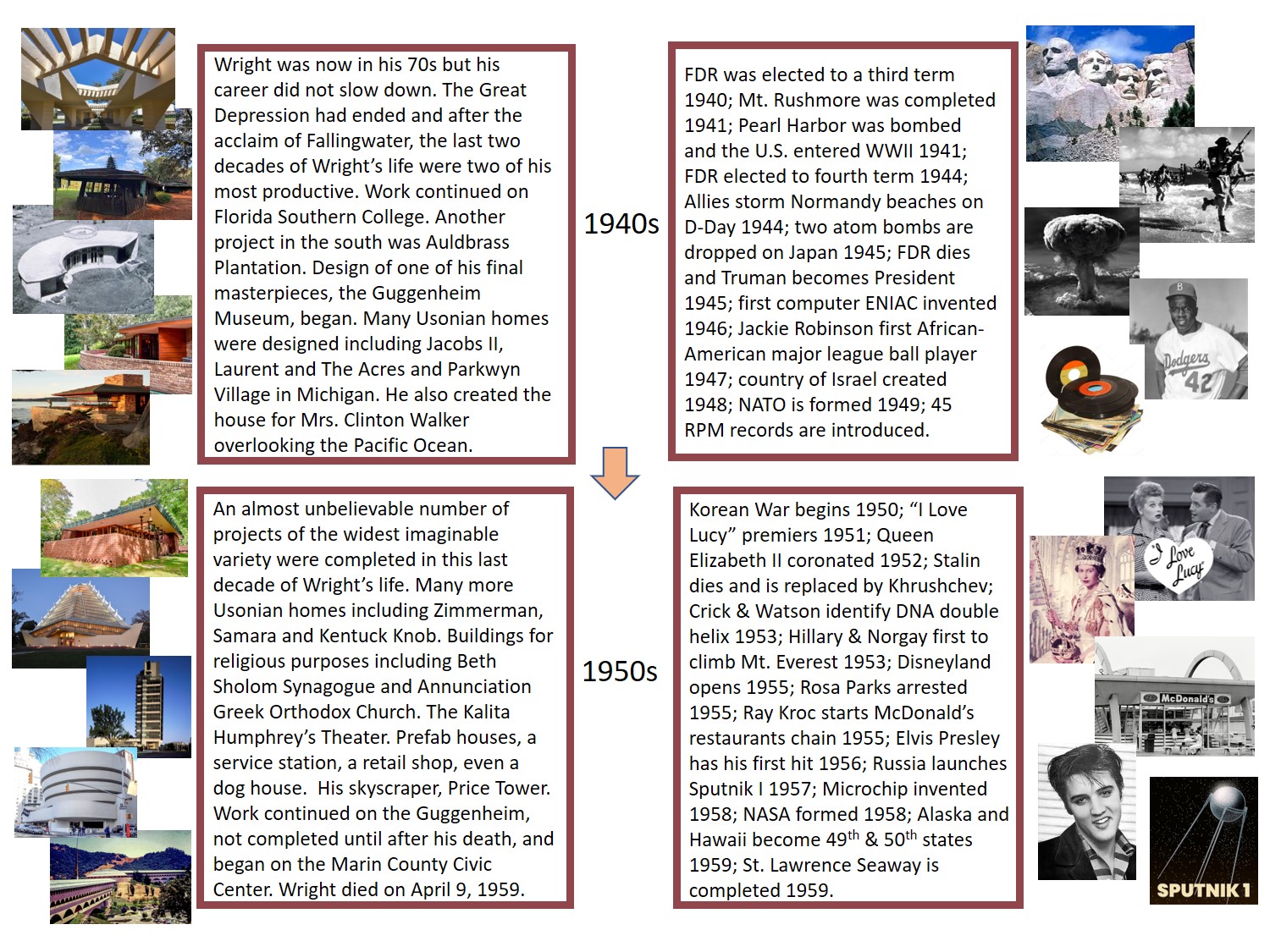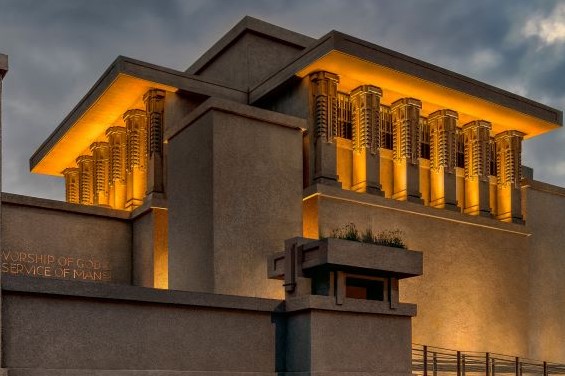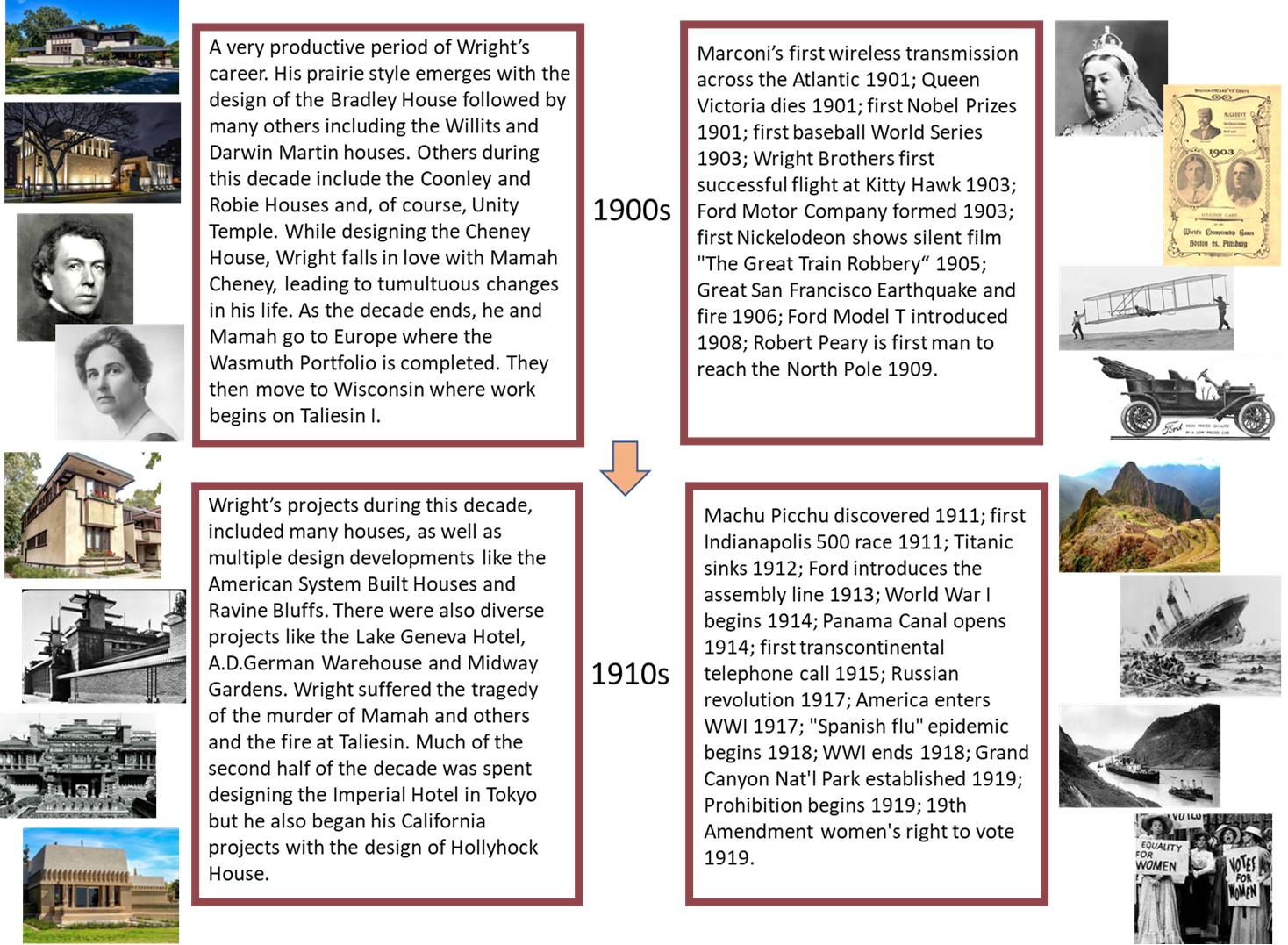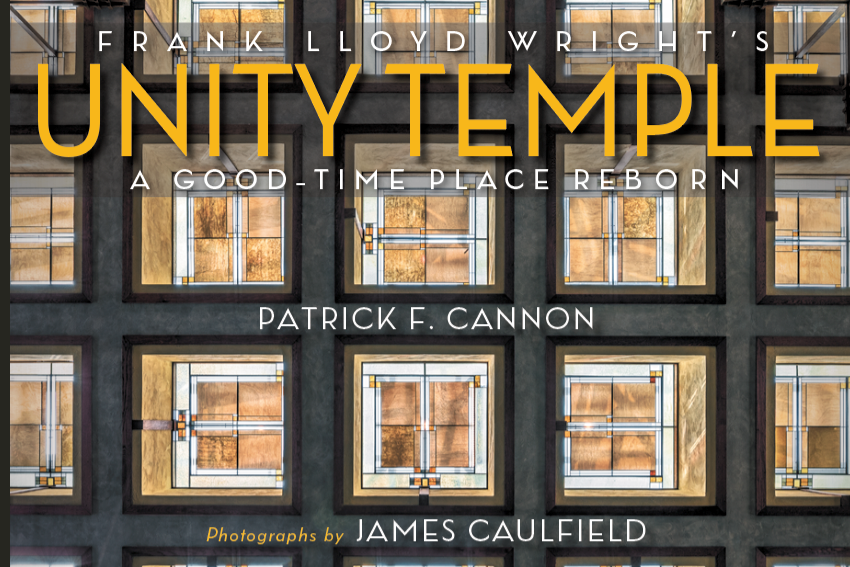 Gunny Harboe of Harboe Architects summed it up at the October 27, 2022, reception for the new book “Frank Lloyd Wright’s Unity Temple: A Good-Time Place Reborn,” by Patrick F. Cannon with photographs by James Caulfield, Unity Temple Foundation, 2022, when he told the attendees that “while drawing the interior, Wright must have had a sudden inspiration, because he hit it here.”
Gunny Harboe of Harboe Architects summed it up at the October 27, 2022, reception for the new book “Frank Lloyd Wright’s Unity Temple: A Good-Time Place Reborn,” by Patrick F. Cannon with photographs by James Caulfield, Unity Temple Foundation, 2022, when he told the attendees that “while drawing the interior, Wright must have had a sudden inspiration, because he hit it here.”
Unity Temple is a UNESCO World Heritage site. Over its entrance, large brass letters herald its function: FOR THE WORSHIP OF GOD AND THE SERVICE OF MAN.
Each function requires a different architectural treatment.
With its dedication on September 26, 1909, Unity Temple in Oak Park, Illinois, Frank Lloyd Wright lighted the way for a revolution leading to a new understanding of architectural interiors and exteriors. He forced semi-liquid concrete walls into molds to petrify a shape and gave them new visual dimensions inside and out by reversing his angular interior as outer planes. To illuminate his interior vision, he elaborated on his definition of windows with a continuous glass screen set in a wall-length opening directly under the ceiling. His choice of colors and wooden trim also broke with wall sculpture traditions.
Overall, the interior and exterior of Unity Temple gave three-dimensional expression with a new adaption of hard edges that flirted in the proximity of the Arts and Crafts and late Art Nouveau angularity, both way signs in the first decade of 20th-century architecture. It was part Glasgow School “Greek” Thomson and Charles Reni MacIntosh, with a flourish of Bruno Paul and Peter Behrens of Berlin, and a visual dose of Paul Cézanne, Pablo Picasso, and Jacque Braque, painters in Paris. Wright was entirely up to date when he nailed this interior. He shone a light on a future he would never experience quite the same again.
 While the exterior of Unity Temple shocked even the dissident 19th century as a sacred space by not following the 1200 years of tradition fossilized by the Roman Catholic Church, aspects of which did align with Unitarian and other traditional anti-Catholic choices of sacred forms. Most striking was Wright’s non-conformism he called bifurcated composition. This plan had already been successfully anticipated, but not yet acclaimed revolutionary, in two sub-urban villas and a sacred structure in Glasgow, Scotland, developed by the much admired Glasgow-based architect Alexander ”Greek” Thomson (1817-1875). As he was affectionately known, Greek Thomson had been prominent in Glasgow and Scotland during the 1850s-1870s but only occasionally had been conversant outside of Scotland. And by 1900, he had slipped into the eddies of architectural history. He remains there today.
While the exterior of Unity Temple shocked even the dissident 19th century as a sacred space by not following the 1200 years of tradition fossilized by the Roman Catholic Church, aspects of which did align with Unitarian and other traditional anti-Catholic choices of sacred forms. Most striking was Wright’s non-conformism he called bifurcated composition. This plan had already been successfully anticipated, but not yet acclaimed revolutionary, in two sub-urban villas and a sacred structure in Glasgow, Scotland, developed by the much admired Glasgow-based architect Alexander ”Greek” Thomson (1817-1875). As he was affectionately known, Greek Thomson had been prominent in Glasgow and Scotland during the 1850s-1870s but only occasionally had been conversant outside of Scotland. And by 1900, he had slipped into the eddies of architectural history. He remains there today.
Thomson’s Double Villa from 1856 and his Holmwood House from 1857 are both realized suburban villas, as was his Chalmers Memorial Free Church on Ballater Street from 1859 in the Gorbals of Glasgow. The villas and the church consisted of three parts: a low horizontal entrance with a central Greek-inspired doorway to its left had a large, tall block with smooth exterior walls pierced by windows separated by square columns. A low-pitched roof covered this block. Attached to its right is a smaller block of smooth exterior walls pierced by a pair of windows, separated by one square column. This smaller wing was also under an almost flat-pitched roof. The Holmwood House remains intact, while the congregation moved out of the Chalmers Memorial Free Church in the 1890s. The building was then partially demolished, and its interior repurposed to accommodate paper merchants and a cork factory before succumbing to fire and being entirely razed in 1971. While a few photographs of the exterior of the Chalmers Free Church appearance exist, no drawings or interior photographs are known.
That Thomson’s church had an uncanny resemblance to Unity Temple was pointed out by Andrew MacMillan in an essay on Glasgow and Chicago in the book “Greek” Thomson, edited by Gavin Stamp and Sam Mckinstry, Edinburgh University Press, 1994. Macmillan discusses how Thomson, then MacIntosh, and then Wright consciously rejected the historical moralizing of ‘Gothic’ revivalism when they realized a new architecture manifesting cultural values blossoming from principal rather than aesthetic whim. They drew in apparent anticipation of the revolutionary social and technical thrust of the soon-to-flower machine-generated Modern movement.
Though Thomson was well known and respected in Scotland and Germany in his day, whether or not Wright knew of Thomson’s Glasgow country villas or urban church remains a mystery. As it stands, Unity Temple in Oak Park may be the culmination of an effective revolutionary Zeitgeist gestating among mid-19th-century to early 20th-century intellectual architects, especially when considering prevailing adverse currents.
Abetting this Zeitgeist, Paul Cezanne, starting in the 1870s, painted what he saw and how he saw it. How we see and understand what we see had been central to intense conversations among the first romantic writers in Jena and Weimar, Germany, during 1793 – 1803, as they were inventing the self. Their ideas spread quickly in post-Napoleonic France and England. By the 1840s, developments in photography helped multiply images. But they were fixed on a metal or glass plate, not reflecting the actual universe of time as it was being understood.
 The French painter Cezanne realized that, unlike a photograph, looking at something in natural light took time and that light was in flux. Physics had already explained that nothing was static. That reality was not as in a photograph, frozen, but in continuous motion. Cezanne applied this thawing realization, noticing that all the while he looked at his subject, the natural light illuminating it changed continuously while its intensity remained constant. Cezanne painted this realization, resulting in subjects that were not crisp, hard, or frozen for the duration he saw them. For him, life was no longer still.
The French painter Cezanne realized that, unlike a photograph, looking at something in natural light took time and that light was in flux. Physics had already explained that nothing was static. That reality was not as in a photograph, frozen, but in continuous motion. Cezanne applied this thawing realization, noticing that all the while he looked at his subject, the natural light illuminating it changed continuously while its intensity remained constant. Cezanne painted this realization, resulting in subjects that were not crisp, hard, or frozen for the duration he saw them. For him, life was no longer still.
At much the same time, motion picture cameras were introduced. Soon pictures “moved” at some 16 to 24 frames per hand-cranked second, mechanically augmenting the natural light Cezanne’s observed with motion in time. Film framing what the eye and mind saw as “moving” was not lost on artists Pablo Picasso and George Braque when, in 1907, they exhibited easel paintings depicting time by marking its increments, much like a clock tick-tock, with their brush strokes in fractured compositions called Cubist. Cubism showed three-dimensional space on a two-dimensional surface. It expanded the vision of time. It was declared new.
But what about architecture, the acclaimed pinnacle of art? Incorporating natural daylight into a three-dimensional space had already been dramatically demonstrated by an oculus in the Pantheon, Rome, or a great ring of many small windows at the base of the dome of the Hagia Sophia, Constantinople, now Istanbul, and then even more profoundly during the northern European Gothic, 12th to 15t century, when the colors in the enormous sun-lit stained-glass windows burst, strobe-like color splatters onto the aisle floors, seating, the devout, and columns determined by the sun’s angle and passing clouds. In its day, this was thought to be God-willed joyous decoration, especially in the winter months when the sun hugged the horizon and shone most deeply into the sacred spaces. The Renaissance and subsequent sacred spaces, including the 19th-century Gothic Revival, did not think much about God’s seasonal intervention.
Pulling color around a corner had been done for centuries. Once invented, it applied to wallpaper, patterned or plain, too. But natural light or shadow on primary colors or patterned papers had a different effect on the eye than on pastel yellow, green, or grays. With his bold behavior, Wright introduced a new game played with pastels, corners, and shadows determined by natural light and, most essentially, the sun’s ever-changing position.
By the time Wright designed Unity Temple (drawings completed 1905-1906, and approved February 7, 1906), scientifically based color theories had long ago explained God’s light not as rendered visible through painted glass but had found its hard truth in Isaac Newton’s scientific demonstration of sunlight fractured by a clear prism into primary colors that could individually be seen. Nature did much the same with drops of water, showing us a rainbow.
 Even with scientific understandings and demonstrations, our human eye continued to see sunlight as only daylight, not a spectrum of bold colors. What humans saw would not separate colors as Newton’s range did so that we could see them in sunlight. But the eye could see something Newton’s prism did not, sunlight’s constant companion, shadow! And the eye noticed that shadow muted colors with insistent grayness and that the frontier separating the two was always a line, an edge. Extending Newton’s observed fact, the German poet and naturalist Johann Wolfgang von Goethe became fascinated by shadow, and subjected sunlight to scientific study as the eye might see it. He concluded that shadows were a uniform lack of primary colors, resulting in shades of gray to black depending on the distance and angle of the light. Other sunlight investigators, including painters and architects, soon agreed. Frank Lloyd Wright was among them.
Even with scientific understandings and demonstrations, our human eye continued to see sunlight as only daylight, not a spectrum of bold colors. What humans saw would not separate colors as Newton’s range did so that we could see them in sunlight. But the eye could see something Newton’s prism did not, sunlight’s constant companion, shadow! And the eye noticed that shadow muted colors with insistent grayness and that the frontier separating the two was always a line, an edge. Extending Newton’s observed fact, the German poet and naturalist Johann Wolfgang von Goethe became fascinated by shadow, and subjected sunlight to scientific study as the eye might see it. He concluded that shadows were a uniform lack of primary colors, resulting in shades of gray to black depending on the distance and angle of the light. Other sunlight investigators, including painters and architects, soon agreed. Frank Lloyd Wright was among them.
In an undocumented eureka moment, Wright applied Goethe’s observed characteristic of light and shadow to the interior of Unity Temple. He did this not with traditional framed windows but with horizontal light screens of clear and small areas of stained glass placed under the ceiling that flooded natural light indirectly at natural angles into the auditorium. Wright broke the sanctuary’s architecture at many right angles, both vertically and horizontally, much like the surface in a cubist painting. These angles maximized the natural light and provided a controlled ebb and flow of dawn-to-dusk natural light and its inseparable companion, shadow.
Akin to northern European Gothic churches, passing clouds cast Unity Temple’s light-washed surfaces into a sudden shadow only to release them just as suddenly. Other surfaces lurking behind hard surface edges were bathed permanently in the flow of lighter or darker shadows. For maximum effect, Wright consciously avoided the centuries-old love of bold colors or surfaces by rendering Unity Temples interiors in pastel yellow and green or leaving some natural light gray of exposed cement. He textured the planes with applied long lines of dark-stained hard-edged strips of angular wood slats. This fools the eye with fully functional, seemingly “decorative” architectural lines. Other than light and shadow, there is no ornamentation. Unity Temple was a whole space concept juggled by light and shadow. Wright’s exhibition quickly became a new understanding of interiors.
In a word, Wright invented the cubist architectural interior in Unity Temple as defined by fields, angles, and lines defined by light, shadow, and time. When completed in 1906, Unity Temple’s interior contrasted with its exterior. When published by Ernst Wasmuth in 1910 Berlin, Wright rang the bell signaling a change of tack for designers that no American, British, or French publisher had been willing to invest in.
Ernst Wasmuth’s publication of Wright’s work was immediately scrutinized in the offices of Peter Behrens, Berlin’s most prominent architect, by Behrens’s three apprentices: Walter Gropius, the senior apprentice; Le Corbusier, then in his second year of apprenticeship; and just starting his apprenticeship, Ludwig Mies van der Rohe. Interrupted by World War One, they would, in the next couple of decades, each in his way, apply Wright’s eureka moment. Their subsequent interiors often had white walls that shone a bright white near the window that quickly progressed, instantly or over time, to ever-darkening gray to black furthest from the window. What color is the wall? Just as in Unity Temple, it depends on where, when, and how long you observe. Yet our mind-eyes know we are looking at a monochromatic surface.
During the early 1920s, this was a radical, new architectural concept that was soon called modern and is today a founding principle of Modernism. So when Frank Lloyd Wright hit the visual bell with Unity Temple and Wasmuth of Berlin published it, it quickly peeled worldwide. It remains a clear vision with Unity Temple as its source. When Unity’s interior is bathed in natural light, its pastel fields are tranquil and please the eye. The shadowed areas render soothing pastel shades of gray.
 (To experience the colors, light, and shadow, a time of at least two hours inside Unity Temple is essential. You will find a superb introduction to the Unity Temple experience in the remarkable color images by James Caulfield in Patrick F. Canon’s Frank Lloyd Wright’s Unity Temple: A Good-Time Place Reborn, published by Unity Temple Restoration Foundation, 2022)
(To experience the colors, light, and shadow, a time of at least two hours inside Unity Temple is essential. You will find a superb introduction to the Unity Temple experience in the remarkable color images by James Caulfield in Patrick F. Canon’s Frank Lloyd Wright’s Unity Temple: A Good-Time Place Reborn, published by Unity Temple Restoration Foundation, 2022)
This summary helps explain the flash of genius that is Unity Temple.
Essay by Rolf Achilles
All photography by James Caulfield

